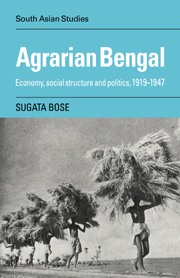Book contents
- Frontmatter
- Contents
- List of maps
- Preface
- List of abbreviations
- PART I AGRARIAN ECONOMY AND SOCIETY: STRUCTURE AND TRENDS
- 1 Introduction: A typology of agrarian social structure in early twentieth-century Bengal
- 2 Subsistence and the market I
- 3 Subsistence and the market II: The peasants' produce
- 4 The peasantry in debt: The working and rupture of systems of rural credit relations
- 5 Peasants into proletarians? The market in land and the question of change in the social organisation of production
- PART II PEASANTS AND POLITICS
- Conclusion
- Glossary
- Select bibliography
- Index
2 - Subsistence and the market I
from PART I - AGRARIAN ECONOMY AND SOCIETY: STRUCTURE AND TRENDS
Published online by Cambridge University Press: 24 October 2009
- Frontmatter
- Contents
- List of maps
- Preface
- List of abbreviations
- PART I AGRARIAN ECONOMY AND SOCIETY: STRUCTURE AND TRENDS
- 1 Introduction: A typology of agrarian social structure in early twentieth-century Bengal
- 2 Subsistence and the market I
- 3 Subsistence and the market II: The peasants' produce
- 4 The peasantry in debt: The working and rupture of systems of rural credit relations
- 5 Peasants into proletarians? The market in land and the question of change in the social organisation of production
- PART II PEASANTS AND POLITICS
- Conclusion
- Glossary
- Select bibliography
- Index
Summary
Rural Bengal in the first half of the twentieth century poses all the conceptual problems and complexities of an agrarian society with an extensive subsistence base which at the same time was tied firmly to a far-flung market. In such circumstances, does the peasantry constitute a distinctive moral and political economy largely retaining its ‘non-maximising subsistence ethic’, or can it be seen as a body of ‘rational economic decision-makers’ responding to ‘market opportunity’? Recent historiography of the peasantry in contemporary South-East Asia has predictably produced antithetical views on a question posed in such antithetical terms. The concept of a hard-headed ‘political economy’ has been set against that of a more benign ‘moral economy’ of the peasant; ‘subsistence ethic’ finds its contrast in ‘investment logic’ as the true motivation behind peasant economic behaviour, and explanations of peasant political protest oscillate between the polarities of ‘moral outrage’ and ‘personal gain’. From a different angle, the relative strength of the impact of demographic and market forces on agrarian economy and society is a question that continues to divide historians of pre-industrial Europe. Even those who treat the evolution of pre-industrial peasant societies within the framework of a demographic model in terms of homeostatic ecosystems are far from agreed on the issue of the peasant response to the market and the efficacy of market forces in bringing about structural change.
- Type
- Chapter
- Information
- Agrarian BengalEconomy, Social Structure and Politics, 1919-1947, pp. 34 - 69Publisher: Cambridge University PressPrint publication year: 1987



